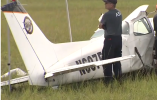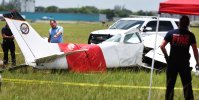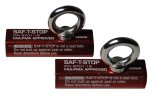In my 1980 N model, during the pre-takeoff control check, you can pull the yoke back and see the elevator & trim tab position through the rear windows to confirm proper trim tab position regardless of where the trim wheel indicator lines up. If that doesn't match the trim wheel position indicator, then the indicator has slipped and you should re-adjust it. It could also indicate that the trim range is not properly set.
Lessons C-172 owners can learn from this tragedy: The front seats have metal safety stops bolted into the back of the rails, so if the seat slides back it only goes so far. Make sure those are installed, inspected and functional. And always make sure your front seat passenger's seat is fully latched into its position. Add to your checklist passenger briefing (you do have one, right?) that if the seat slides back on takeoff, do not grab the yoke. You don't have to grab anything, just let it slide, we can adjust it later in flight. Similar to a door popping open in flight, it is not an emergency unless you over-react and turn it into an emergency.



